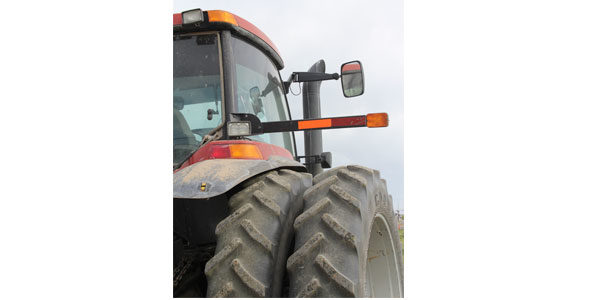Completing a few basic safety checks before going to the field can bring you peace of mind and hopefully prevent an incident from occurring.
This is especially important for producers spending more time on the road to farm distant acreages and those working near more densely populated areas.
One of the easiest and most cost-effective things you can do to improve over-the-road safety is checking the reflectiveness of slow-moving vehicle (SMV) stickers and signs on farm equipment.
SMV emblems are required on the rearmost piece of equipment in most states. They communicate to motorists that a farm vehicle, which may not be capable of maintaining speeds greater than 25 mph, is ahead.
Unfortunately, SMV signs fade over time with exposure to the elements. The good news is: It is easy to renew any SMV sign by placing a new sticker on top of the old one.
While you are at it, consider adding reflective tape to your mowers, wagons and other equipment. Reflective tape and fluorescent sticks can be attached at the widest point of an implement, where practical, to help indicate its width to passing motorists.
While lights are still the best way to warn approaching vehicles that farm equipment is on the roadway, the beauty of reflective tape is that it maintains visibility even if a lighting system fails.
For oncoming traffic, the configuration of lighting on farm equipment can be confusing and sometimes blinding.
Tractors and mowers should have at least one white light on the front of the vehicle, visible from 500 feet, and one red light to the rear of the vehicle, visible from a distance of 300 feet.
Newer tractors and mowers often have yellow or orange rotating lights and reflectors incorporated to help motorists recognize that a large piece of equipment is ahead.
After-market strobes and reflectors can be added in similar configurations to older equipment to help increase recognition and visibility.
In your pre-harvest maintenance checks, test all lights to make sure they work and are aimed properly. Bulbs, wiring and fuses or circuit breakers can be issues on older equipment.
Check both the “high” and “low” beam lights. Clean light and reflector covers. These simple steps can improve an operator’s ability to see the road and substantially reduce the potential for blinding oncoming traffic.
Mirrors are among the most important pieces of safety equipment on a tractor or self-propelled mower. They are also exposed to some serious abuse from tree limbs and barn doors.
A quick check of mirror placement, cleanliness and state of repair can help to improve operator awareness of approaching traffic.
Mirrors may need to be extended or upgraded to accommodate especially large tow-behind implements or wagons.
A fire extinguisher should be mounted on every piece of self-propelled equipment for rapid response to ignited engines, bearings or plant material.
A 10-pound ABC-type extinguisher is recommended, and an annual inspection will keep it in good working order.
Examine the extinguisher for any obvious physical damage, corrosion, leakage or clogged nozzle. Confirm that the pressure indicator is in the appropriate range and lift the extinguisher to ensure it is still full.
This simple tool can prevent a small fire from burning out of control, causing massive potential losses.
Newer safety technology has continued to become more affordable and is certainly worth a look. Many growers have incorporated aftermarket rear-facing cameras with in-cab monitors to see behind and around equipment.
Good-quality agricultural camera systems are available for $900 to $1,000. They can greatly improve operator visibility compared to conventional mirrors.
Others have opted to install multiple camera systems to make loading and unloading easier in addition to improving over-the-road safety.
Don’t forget a wagon safety check. Wheel-bearing failure and tire blowouts are common problems that occur with loaded wagons. Inspect wheel bearings for “play” and smooth operation.
Frequent monitoring of wear on tires can save both time and bucketloads of frustration that result from having to fix one of these problems in the field or alongside a road. Mounting brackets for silage boxes should also be checked.
Finally, make sure wagons have safety chains of adequate strength to keep your load with the tractor in the case of a hitch failure. Welded links often lose strength, so safety chains should be connected to the implement hitch or frame with the correctly sized connecting link.
Improving the soundness and visibility of your forage equipment before traveling on public roadways is a simple way to enhance safety and avoid a potentially costly accident.
For more information on over-the-road transportation safety, consult the “Michigan Farmer’s Transportation Guidebook,” a joint publication of the Michigan State Police Traffic Safety Division and the Michigan Farm Bureau. FG
James DeDecker and Bruce Mackellar are educators with Michigan State University extension.










